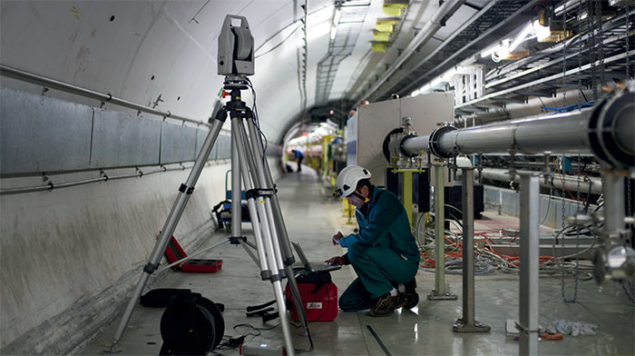
Image credit: M Brice/CERN.
On 14 September, CERN injected a beam of partially ionised xenon atoms into the Super Proton Synchrotron (SPS) and kept it circulating for a short period. The successful demonstration, carried out by the SPS operations and radio-frequency teams, is the first of a series of experimental steps to explore the feasibility of a gamma-ray source with an intensity several orders of magnitude higher that those currently in operation.
Earlier this year, CERN’s accelerator complex demonstrated its flexibility by producing a beam of fully ionised xenon atoms for the fixed-target experiment NA61, which studies the physics of strong interactions. Profiting from this achievement, the gamma-factory study group – which is part of CERN’s Physics Beyond Colliders study – requested dedicated beam tests with partially ionised xenon atoms in the SPS. The beam was composed of xenon nuclei carrying 15 out of the 54 electrons present in the neutral atom, the missing 39 electrons having been stripped off before reaching the SPS.
The xenon beams injected into the SPS are the most fragile of any beam so far accelerated to, and stored at, ultra-relativistic energies at CERN. A loss of even a single electron changes the magnetic rigidity of the stored particles and leads to beam loss. The losses for the xenon-39 beam due to interactions of the beam with the residual gas in the SPS vacuum pipe were expected to be severe, and the tests confirmed that the beam lifetime is indeed short (of the order of one second). However, the lifetime is expected to be significantly higher for lead beams with only one or two attached electrons, which are the principal candidates to drive the high-energy gamma factory. Tests with lead atoms will be carried out next year in parasitic mode during the LHC’s heavy-ion programme, when the CERN accelerator teams aim not only to inject partially ionised lead atoms into the SPS but also into the LHC.
Light source
An eventual gamma factory would use beams of highly ionised atoms to drive a novel type of light source. The idea is to insert the ion beams into a storage ring and illuminate them with a laser that excites the electrons to a higher energy state, leading to spontaneous emission of secondary photons. In this scheme, the initial laser-photon frequency is boosted by a factor of up to 4γ2L, where γL is the Lorentz factor of the ion beam. With the LHC as a storage ring, photons in the energy range 1–400 MeV would therefore be possible. Such a source of gamma rays would open many scientific opportunities, such as precision atomic electroweak physics with high-Z hydrogen-like atoms, dark-matter searches using photon beams, and neutron dipole moment and neutron–antineutron oscillations. It would also act as a test bed for a future neutrino factory or a TeV-scale muon collider, says the team.
Meanwhile, independent activities during machine-development periods this year will see xenon atoms injected and brought into collision in the LHC. “The beauty of the operation mode of the CERN accelerator complex is not only that the xenon-39 beam tests in the SPS could be done with no influence on the LHC pp operation, but that they could be done concurrently to injecting and accelerating other types of beam in the SPS – e.g. two cycles for the fixed-target programme and one parasitic cycle for xenon-39,” says Witold Krasny of the gamma-factory study group.
CERN’s Physics Beyond Colliders initiative was launched in 2016 to explore the opportunities offered by the CERN accelerator complex and infrastructure “to get new insights into some of today’s outstanding questions in particle physics through projects complementary to high-energy colliders and other initiatives in the world” (CERN Courier November 2016 p28).







